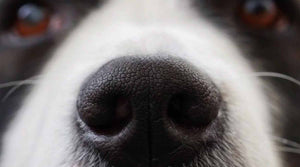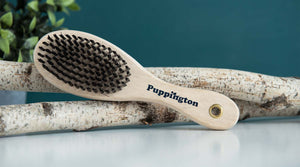Your Cart is Empty
FREE SHIPPING SITEWIDE!! | TAKE THE QUIZ & SAVE 15%
FREE SHIPPING SITEWIDE!! | TAKE THE QUIZ & SAVE 15%
FREE SHIPPING SITEWIDE!! | TAKE THE QUIZ & SAVE 15%
June 15, 2021 12 min read
Dog skin allergies are much more common than many people think. In fact, one in five dogs has at least one allergy to something and about 10% have a serious food or contact allergy!
These can lead to itchy pups with dry dog noses and excessive scratching, redness, hair loss and other symptoms of discomfort that your dog will not be able to ignore.
Dogs' skin allergies are often overlooked because they can be difficult to diagnose... but we're here with the lowdown on what a skin allergy is, what causes them, and how to treat them naturally!
If you're reading this, chances are you've heard of dogs having allergies. If not, it’s quite common for dogs to have allergies, and unfortunately - it’s just about as frustrating for them as it is for us! Dog skin allergies - and a leading symptom called canine atopic dermatitis - are a common problem, and it can be difficult to determine their exact cause. You may think your pup has just been scratching too much, but then you realize that it doesn't happen when they’re at the park or out on a walk. It's more likely that they’re allergic to something in the house!
Dog allergies can manifest themselves in various ways from skin irritation to ear infections or even gastrointestinal issues. They are often triggered when the body's immune system overreacts to a harmless protein that it mistakenly perceives as dangerous. Dogs are affected by food and environmental allergens just like we are. Their physical reactions can even be similar to human reactions, manifesting as hives or eczema in response to allergens.
A dog's skin is similar to human skin in its vulnerability to allergies, and what’s more, some dog allergy symptoms have environmental causes. Some common allergens include pollen, mold spores, and dust mites, which can be found indoors and outdoors. These are all environmental allergens and require different treatment approaches than food allergies. So - your pup may be allergic to something they’ve eaten (such as beef) or to some type of pollen floating around their environment.
Unfortunately, your pup cannot tell you what they are allergic to. Sometimes it is up to us dog parents to help root out the causes of our dogs’ skin allergies. If your dog is itching and scratching a lot, read on to discover how you can provide your itchy dog relief with simple, natural remedies.
Environmental allergies in dogs
Environmental allergies are more common in dogs that spend more time outdoors, as they may develop and worsen in dogs over time. Dogs with environmental allergies may also be genetically predisposed to the condition, with some dog breeds more likely to be affected by environmental allergies than others.
Dog breeds that are prone to environmental allergies include:
Most environmental allergens are not otherwise harmful per se, but varying immune system sensitivity to different environmental substances can produce a lot of uncomfortable symptoms.
Environmental allergens can lead to itching, skin irritations, and can even cause a dog's nose to dry out.
A dog’s immune system can also become increasingly sensitive to an environmental substance over time, with repeated exposure.
Environmental allergens that affect dogs include:
Pollen
Pollen from grass, weeds, flowers, or trees often triggers allergic reactions in dogs. While humans sneeze and cough from pollen allergies, dogs may not only sneeze or get congested but also scratch, lick, and rub, desperately seeking relief. Pollen also triggers seasonal allergies that can lead to ear infections.
Weeds
Ragweed is another cause of seasonal allergies in dogs. Ragweed grows more toward the end of summer and the start of fall. When you notice your dog itching and chewing their paws, it could be a ragweed allergy. Other symptoms to look for include sneezing and coughing.
Fungi
Yeast fungus can cause malassezia dermatitis in dogs. Abnormal growth of this fungus triggers skin itching and inflammation.
Mold
Many types of mold are usually harmless in very small amounts. However, inhalation of mold spores in very sensitive dogs can lead to itchy skin and exposure can even cause their skin to become excessively dry and scaly.
Fleas
Flea allergy dermatitis in dogs is caused by - you guessed it! - flea saliva. The most obvious symptom of flea allergies is severe itching. Excessive scratching leads to skin inflammation and hair loss. Abnormal self-grooming behaviors can also be a sign of flea allergy dermatitis.
Animal dander
Interestingly enough, dogs can develop allergies from the dander of other animals. Dander from other dogs, cats, birds, reptiles, and farm animals can trigger allergy symptoms like itching, scratching, sneezing, and a runny nose. Some dogs may develop an itchy nose, mouth, or throat. Coughing, facial pain, and nasal congestion are other symptoms of allergies from animal dander.
Dust mites
Dust mites cause severe dog skin allergies compared to fleas. About 80% of dogs suffering from atopic dog dermatitis can trace the cause back to dust mites. Dust mites are rampant in the fall when it is cool and indoor humidity from the end of summer rises.
Most environmental allergies, except seasonal ones, need to be managed year-round. Fortunately, there are natural ways to keep your dog more comfortable and reduce their symptoms without breaking the bank.
Natural remedies for dog dermatitis
There are natural, holistic remedies for treating atopic dermatitis and providing your itchy dog relief. Pup Wax® uses several of these natural ingredients to help alleviate your dog's itching, to help with redness and inflammation, and to help maintain a clean, healthy coat.
Before trying any of these natural ingredients, ask your vet to sign off on your choices. A vet should be willing to work with you to confirm the culprits behind your dog’s allergy symptoms.
Popular natural ingredients for treating dog skin allergies include:
Note, some of these natural ingredients only alleviate symptoms and may not completely heal or prevent a condition.
That said, using prescribed medication alongside these home remedies can often help you achieve the best results.
Coconut oil
Coconut oil is a topical solution for canine atopic dermatitis. You can use it to treat canine eczema, skin allergies, and yeast infection. Coconut oil also reduces pain and inflammation from insect stings and bites. Massage coconut oil on the coat and skin to provide relief to affected areas.
Pup tip: Organic virgin coconut oil is a main active ingredient in Pup Wax®
Oatmeal bath
An oatmeal bath is an ideal solution for addressing dry, itchy skin and paws in dogs. Put warm water in a bathtub and sprinkle colloidal oatmeal into it. Let your dog soak in the bath for about 15 minutes. Alternatively, mix colloidal oatmeal with a very small amount of warm water in a bowl until it forms a fine paste, and then apply the paste directly onto the dry, itchy parts of your dog's skin.
Shea butter
Shea butter helps address the problem of severe scratching, licking, and biting. Shea butter is great for treating winter-chapped elbows, paw pads, and dry dog noses.
Pup tip: Organic, raw, and unrefined shea butter is one of the active ingredients in Pup Wax®
Apple cider vinegar
Apple cider vinegar is an effective solution for soothing itchy dry skin. Mix equal amounts of apple cider vinegar and plain water in a spray bottle. Spray this solution on affected areas once or twice a day to provide relief.
Caution: Do not use an apple cider solution on cracked or cut skin.
Hempseed oil
Hempseed oil contains natural fatty acids that help fight dry dog skin. Hempseed oil also prevents recurring dog skin problems such as a dry nose, eczema, rash, acne, and canine dandruff.
Pup tip: Guess what? Organic hempseed oil is one of the active ingredients in Pup Wax®
Beeswax
Beeswax is a natural remedy for treating chapped and dry dog skin, noses, and paws. Beeswax forms a moistening emollient barrier over dry cracked paws and adds a protective layer to help prevent further dryness. Apply a beeswax-based balm at least twice a day to keep your dog’s paws moist and prevent them from cracking.
Pup tip: Pup Wax® has enough beeswax to keep your dog’s paws moist and soothed all year round!
Plain yogurt
Plain yogurt fights yeast infections caused by an overgrowth of fungus in a dog’s gut. Feeding your dog sugar-free natural yogurt may also reduce skin irritation, rashes, allergies, and hives. A teaspoon of yogurt is enough for toy breed dogs. Two teaspoons are enough for most large dog breeds.
Pup tip: If your pup is lactose intolerant, skip the yogurt!
Chamomile-herbal tea
Green tea and chamomile tea both have compounds that help give an itchy dog relief. Fill a tub or sink with warm water and drop in several herbal tea bags. Let the tea bags sit in the water for about three minutes and remove them. Let your dog soak in the bath for 5 minutes or more.
Alternatively, dip an herbal or chamomile tea bag into a cup of hot water. Allow the water to cool down before dipping a clean cloth into it. Dab the soaked cloth onto any itchy patches to provide relief.
Be sure to tidy up your dog’s outdoor space
If you suspect environmental allergies, clear out tall grass, weeds, leaves, or bushes that may disperse pollen onto your dog’s coat or skin. Bathe your dog with a mild pup-approved shampoo to soothe the itching and scratching and get rid of any pollen and other irritants that may have settled onto their fur or skin.
Food allergies in dogs
Food allergies in dogs stem from a false autoimmune response. An allergic dog’s immune system identifies a generally harmless food ingredient as dangerous. In most cases, proteins are the major causes of food allergies in dogs.
Food allergies are often confused with food intolerances. With a food intolerance, a dog is unable to digest a specific food. It may be triggered by veggies, milk, or a new ingredient that was recently introduced into their diet.
Food allergies trigger the immune system to negatively respond to an otherwise non-threatening protein or other substance. Such proteins can be found in both meat and vegetables, and other food allergies are of course also possible.
Canine food allergies often go undetected. As a dog ages, its body constantly goes through changes. It is not uncommon for a dog to eventually develop food allergies to foods in a diet that they had eaten for years. Even on a high-quality diet without fillers, your pup can still develop food allergies to one or more ingredients in that food.
It is important to identify the exact protein that is causing an allergic reaction in your dog. Common foods that are likely to cause allergies in your dog include the following:
Allergies to dairy products often cause dogs to itch and scratch. This is different from a lactose intolerance, which typically causes bloating, vomiting, or diarrhea. While food allergies to dairy products may cause these symptoms as well, excessive itching and scratching are more often the hallmark of a food allergy.
Beef contains all essential amino acids. Any of these amino acids can trigger an auto-immune response in beef allergic dogs that manifests as dog skin allergies. Beef is also a very common ingredient in dog food, so it’s a good starting point for discussion with your vet if you think your dog shows food allergy symptoms.
Egg allergies typically stem from a protein in egg yolk. Removing the egg yolk may stop the allergic reaction; if symptoms persist, consider removing eggs completely from your dog’s diet.
Pup tip: Since many dog foods include eggs, it is always crucial to read ingredients to avoid accidental ingestion.
Wheat contains high amounts of the protein gluten. Like humans, dogs too can grow allergic to gluten, triggering a harmful immune response. While many dog food products contain wheat, fortunately, there are plenty of gluten-free dog food brands on the market today.
CAUTION: Going gluten-free does not require going grain-free! There are many healthy grains which are naturally gluten-free, such as quinoa and oats. Do not put your dog on a completely grain-free diet without consulting with your dog’s vet, as recent studies have indicated that grain-free diets have negative health effects on certain breeds.
Lamb is a go-to option for dogs with other protein allergies. However, if your pup is allergic to lamb as well, consider switching to an alternative such as chicken, turkey, or fish. Some dog food brands contain a lamb-rice combo; a great alternative to this combination are the venison-sweet potato-based meals.
Soy is not a recommended dietary ingredient for many dogs. Besides triggering allergic reactions,research studies do not indicate that feeding a dog a soy-based diet contributes to better health. Soy is a phyto-estrogen, or a plant which mimics estrogen in the body and can cause hormonal disruptions. Some dogs who have developed soy allergies seem to be at increased risk of developing thyroid, liver, and growth problems.
Artificial preservatives and food coloring in dog food
Besides proteins, artificial preservatives and food coloring are other hidden culprits that can lead to dog skin allergies. These artificial additives are used to change the color or increase the longevity of commercially processed food.
Artificial preservatives
Artificial preservatives are especially common in low-cost, low-quality dog food. They can trigger itchiness and skin swelling. In severe cases, artificial preservatives in dog food can cause chronic dermatitis.
The common preservatives in dog food to watch out for include:
Ethoxyquin is a common artificial preservative in processed fishmeal. If any of these preservatives are on your dog food label and are causing food allergies, try switching to a different brand. Many vets recommend dog foods that contain natural ingredients that act as preservatives such as citric acid, rosemary extract, and tocopherols (vitamin E).
Dog brands that use natural preservatives are often more costly because they are less effective, which means more natural foods will naturally have a shorter shelf-life - but do you really want to give your dog food that can sit on a shelf for years on end? Talk about unnatural!
Artificial food coloring
Dog food brands use artificial coloring to make their products appealing to human shoppers with bright, unnatural colors. Yet, studies show that dogs react negatively to artificial food coloring, just as humans may, and dogs experience the same adverse health effects. Most dog food brands commonly use the following artificial food coloring:
Yellow 5 or tartrazine (E102) is a food dye commonly used in human and dog food. Medical studies show that excess Yellow 5 causes neurochemical and behavioral changes in dogs. Symptoms associated with this artificial food color include hyperactivity, insomnia, and aggression. Yellow 5 AFC is linked to more severe conditions like thyroid tumor, ADHD, lymphomas, and chromosomal damage.
Red 40 is the dye behind bright crimson red coloring in dog treats and foods. Red 40 is thought to promote cancer with repeated exposure. Studies also show that Red 40 can cause hyperactive behaviors.
Blue 2 is a food dye that gives soft drinks a blue color. Like Red 40, this artificial food coloring has carcinogenic compounds. Furthermore, the Blue 2 food dye is believed to negatively affect brain cell development.
Yellow 6 is a major culprit for dog skin allergies. This food dye can also trigger asthma and cellular damage. Other reports indicate that Yellow 6 can cause cancer, especially kidney and adrenal gland cancer.
Food allergy dermatitis
Canine atopic dermatitis or dog dermatitis (often characterized by itchiness, hot spots, or hair loss) is the most common symptom of canine food allergies, but there are other symptoms to watch out for such as
Some dog breeds are predisposed to food-related dermatitis more than others. They include
Dietary Improvements
With your vet’s approval, try switching your dog to a different high-quality diet to ease symptoms and reduce itching and scratching. Ensure your dog’s diet has enough proteins and is low in excess fats & carbs (for a dog!) If you have any doubts about your dog’s nutritional needs, discuss these with your vet first. Try to avoid any soy-based wet or dry dog foods as well as those containing low-quality protein by-products.
Conclusion
Does your dog have a constant itch that just won’t quit? There are many possible reasons for this, but one possibility that stands out right away is an allergic reaction to their diet or environment. It may be time to look into switching their foods or trying elimination diets (with your vet’s approval and guidance, of course!) If you think the cause(s) may be environmental, maintain a clean space for your dog where they can roam free without chemicals like cleaning supplies or pesticides.
If you’ve been giving your itchy pup relief with natural home-based remedies and are ready for a convenient and effective solution that can be used anytime, try Pup Wax®! Pup Wax® is the first & only 100% clean skincare for dogs, made from the highest quality ingredients - so your dog can enjoy fast relief from their skin irritation - no matter what caused it! Pup Wax® includes organic hempseed oil to help with redness and inflammation while organic virgin coconut oil will keep your pup’s coat shiny and healthy looking. Find the best Pup Wax® for fast relief for your pup now!



Comments will be approved before showing up.